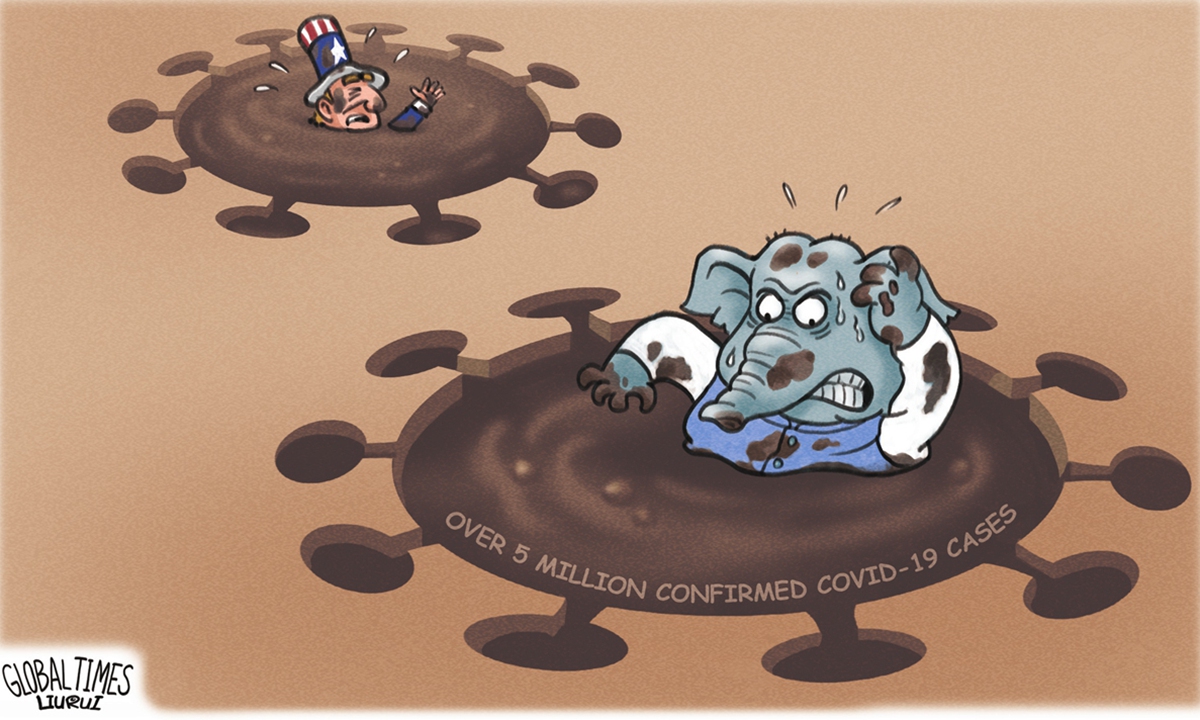Army infections unmask India's struggle to sustain border bluffs
By Li Jie Source: Global Times Published: 2020/9/20 21:13:40

Illustration: Liu Rui/GT
The Indian Minister of State for Defence Shripad Naik said at a meeting on September 16 that about 20,000 Indian military personnel have been infected with COVID-19 so far.
For the government's interest, India may still insist on sending troops to the China-India border. As it has seen a relatively large increase in the number of people infected with COVID-19, the need for draft and increased weaponry in the future is likely to be the main path for the Indian army. It is known that the China-India border clash was significant for the Modi administration to make the issue into political capital. As a result, whether it can be well prepared for the winter, as the Indian military calls it, may depend on how much support it can get from the US. But the US military has topped 42,659 positive tests of COVID-19 as of Friday and they continue to struggle to keep it from spreading amongst their ranks.
Although it may not have a fatal impact on the overall deployment of the Indian army, it certainly puts pressure on the allocation of combat resources and equipment for any future scenario.
Some Indian media outlets have distorted the facts about this, claiming that it is the Chinese soldiers who are causing trouble along the border and posing a threat to India. I wonder if those indignant populists would want to go to the front and take the risk of freezing to death in the upcoming winter.
India, at this stage, has no choice but to struggle and perhaps even intensify its provocations on the border. However, if the number of infected Indian troops increases or the situation becomes more unfavorable to New Delhi, it may resort to negotiations to resolve disputes.
Washington will undoubtedly give more support to New Delhi to make trouble in the China-India border areas. As the Taiwan card is no longer helpful to the US, the only tools available to the US are making wave in the South China Sea, its alliance in the Indo-Pacific region, and pressing and supporting India overtly and covertly. The Modi administration now has no chips to play because they have completely lost control of the epidemic. India has such a large population base that it is estimated that it may soon surpass the US in terms of the number of infected cases. It is partly because Prime Minister Narendra Modi cares more about making political capital and his personal reputation as well as India's status in the international community. Therefore, the epidemic will be very likely to spike on his watch.
Some Indian media outlets have tried to play the truth down that more than 5 million people are infected in their country. The severer the epidemic is, the stronger the need of the Indian government to divert domestic attention will be. This is also India's guiding rationale for putting the blame on China. With a significant increase in the number of infected soldiers, Naik has publicly proposed that soldiers died or injured due to COVID-19 will not be compensated. This has had a great impact on the morale of the troops, since most of the soldiers are from local states and have families to support. Combined with uncontrolled local virus spread, the Indian army's infection rate will only get worse.
In truth, India's military might is not as strong as they have always claimed. Sadly, they do not have a clear picture of that. In other words, if they are not backed by the US, India itself will have no military power to compete with China. However, the virus continues to rage out of control in the US. To divert the domestic attention away and cover up the fact that US military can hardly take care of itself, Washington keeps bluffing and provoking conflicts against China. They are doing this by conducting military exercises in the South China Sea and the Taiwan Straits. Egging India and the island of Taiwan into conflicts is actually serving the political strategy of the US.
The author is a Beijing-based naval expert. opinion@globaltimes.com.cn
RELATED ARTICLES:
Posted in: VIEWPOINT,CHINA-INDIA